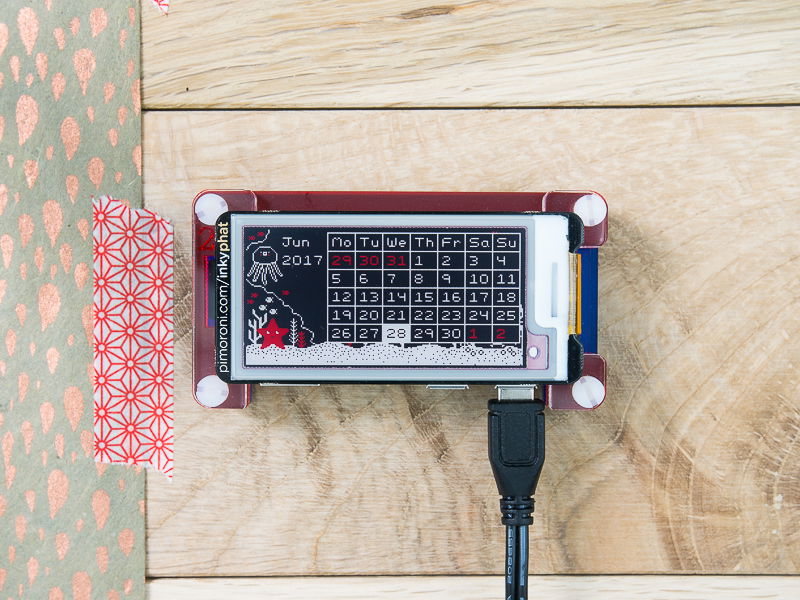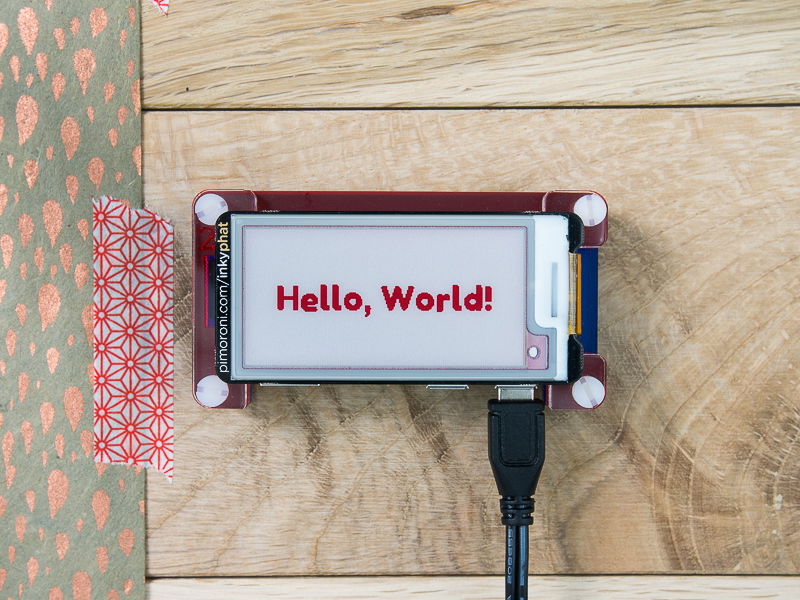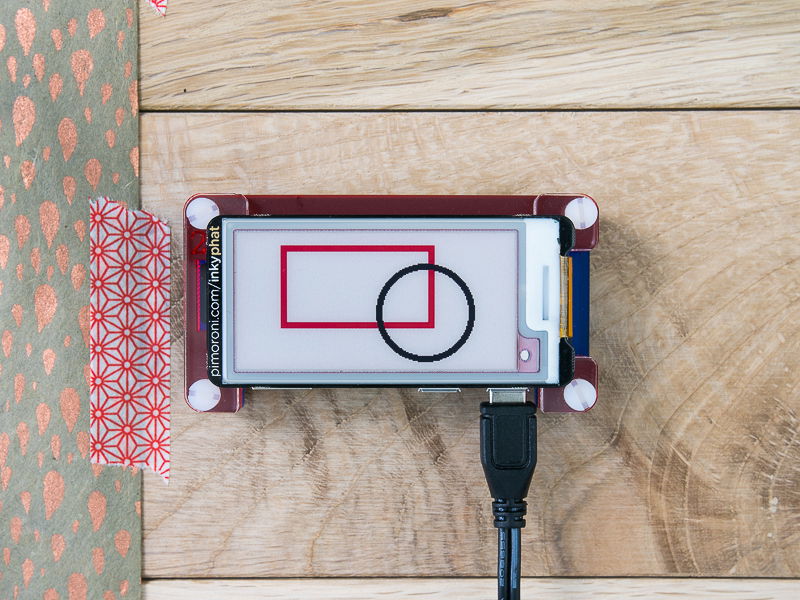Getting Started with Inky pHAT
This tutorial will show you how to install the Inky Python library, and then walk through its functionality. You'll learn how to run the beautiful included examples: the name badge, calendar, and weather station, and then learn how to display text and images on Inky pHAT.
You'll see that your Inky pHAT already has an image on it, straight out of the bag! This is because e-paper displays, like the one on Inky pHAT, allow you to update them with an image and the image will persist even once you've cut the power supply (i.e. switched off your Pi, or even removed the pHAT altogether)! This means that you can use Inky pHAT as a fancy-pants name badge, completely sans power.
Because Inky pHAT comes fully-assembled, there's no need to solder anything, so you can just pop it onto the GPIO pins on your Pi / Pi Zero / W and get going!
Revision history
- 09/2025 - Updated to work with the new, four colour Red/Yellow/Black/White Inky pHAT variant.
- 09/2024 - Updated to work with Raspberry Pi 5 / Bookworm / virtual environments.
Installing the software
For this part of the tutorial, you'll need a micro-SD card that's been flashed with Raspberry Pi OS and to be connected to Wi-Fi. It's also really handy to have a display, keyboard, and mouse connected to your Pi for these next bits.
We recommend using Raspberry Pi OS Bookworm or later, and if you're a beginner it's best to use the full version ("with desktop and recommended software"). This tutorial will only cover how to set things up with full version of Bookworm, as it has most of the dependencies that we'll need to run the examples.
It's a great idea to start with a fresh install of Raspberry Pi OS or, if not, then make sure that you run sudo apt update and sudo apt upgrade in the terminal to get everything up-to-date.
Open a terminal (press control-alt-t or find it in the Raspberry Pi menu) and then type the following:
git clone https://github.com/pimoroni/inky
cd inky
./install.sh
Once that's all done, type sudo reboot to reboot your Pi and apply the changes to the Pi's interfaces.
The install script enables and configures I2C and SPI and also (optionally) will set up a virtual environment for you, which you will need to be able to install Python packages in recent versions of Pi OS. If you'd like to read more about virtual environments check out the Raspberry Pi documentation or our overview.
Running the built-in examples
The Inky Python library comes with a handful of really beautiful examples.
The examples, that live in the ~/Pimoroni/inky/examples folder, are
divided into universal ones that work with both the pHAT and wHAT in the topmost
folder, and then those that are specific to the pHAT or wHAT in the phat and
what folders respectively.
We'll look at how to run one of the universal examples on the pHAT now, the name badge example. This example takes some command line arguments that specify the type of display (pHAT, in this case) and colour of display that you're using. Command line arguments are extra pieces of information that you can pass into programs straight from the command line.
If you let our installer copy the examples then they will have been downloaded to ~/Pimoroni/inky/examples (if not, you can find them in the cloned ~/inky/examples directory). Open a new terminal window, and type the following to
navigate to the examples folder:
cd ~/Pimoroni/inky/examples
You can view the examples that are stored in this folder using the ls command.
To run an example, you'll first need to switch to your virtual environment - if you let our installer set one up you can type this command in the terminal to do that:
source ~/.virtualenvs/pimoroni/bin/activate
Name badge example
Let's try the name badge example. It takes three arguments - --type,
--colour, and --name - the names of which should be fairly self-explanatory.
In the terminal, type the following:
python name-badge.py --type "auto" --colour "red" --name "Inigo Montoya"
(You can also use -t, -c, and -n)
Note: The --type "auto" part of the command above reads the information stored in the EEPROM (a tiny memory chip on the Inky pHAT that we program during the manufacturing process) to identify what kind of pHAT or wHAT it is. Some older Inkys don't have this chip, so if you get a "no EEPROM detected!" error you'll need to specify what kind of Inky it is by using --type "phat" instead of --type "auto".
It'll take a few seconds (around 15 usually) to update the whole display. e-paper displays work by pulling coloured particles up and down using different voltages, so that's what all the pulsing of the display is (and why the image persists).

The above assumes that you're using the red/black/white or four colour Inky pHAT. If you're
using a yellow/black/white or a black/white Inky pHAT then change "red" to
"yellow" or to "black" accordingly. And obviously change your name from
"Inigo Montoya", unless that really is your name?!
As we said earlier, you can now completely detach your Inky pHAT and use it as a completely powerless name badge, although it should be noted that the image may fade gradually over the course of a day or so, but you can easily perk it up again by reconnecting it to your Pi and running the script again.
Calendar example
We'll look now at the calendar example. This example draws a neat little calendar on your Inky pHAT, with days from the current month in white, overhanging days from the previous and next month in red, and the month and year to the side.
This example is specific to the pHAT but it does take one argument, to specify the colour of Inky pHAT display being used.
In the terminal, type the following to run the calendar example:
cd phat
python calendar-phat.py --colour "red"
Again, we're assuming that you're using a red/black/white or four colour Inky pHAT, but if
you're using a yellow/black/white or a black/white one then change the --colour
to "yellow" or "black".

Note that if you want to have the calendar always on and updated then you would
have to re-run the script periodically using crontab, as follows. In the
terminal, type:
crontab -e
If it's the first time you're setting up a crontab, you'll need to select a text editor - press 1 and enter to open up nano. At the very bottom of your crontab file, add the following line, replacing USER with the name of the user account that you use to log into Raspberry Pi OS:
*/30 * * * * /home/USER/.virtualenvs/pimoroni/bin/python ~/Pimoroni/inky/examples/phat/calendar-phat.py --colour "red"
That will run and update the calendar every 30 minutes, although you can change
that number to a smaller or larger number depending on how frequently you'd like
it to update. (It's ctrl-x to close nano when you're done).
Weather example
Next, we'll take a look at the weather example. It displays the time and date at which the weather was last updated, a little icon describing the current weather, and the temperature and wind direction at your chosen location.
You can set your chosen location by changing the CITY and COUNTRYCODE
variables in the weather-phat.py script. The defaults are set to "Sheffield"
and "GB", for obvious reasons...
To run the example, type the following in the terminal:
python weather-phat.py --colour "red"
The same goes for different colours of Inky pHAT display again...

And again, if you want the example to run periodically and keep the weather
updated on your Inky pHAT, then you'll need to use crontab, as in the example
above. A good frequency at which to run this one is probably every ten minutes.
Building your own code
Let's take a look now at how to build your own code with Inky pHAT. Because of the way that the new universal Inky library works now, there's some boilerplate (yadda yadda code!) that we need at the top of any code we're going to run.
In the terminal, type python to open a Python prompt.
Here's the boilerplate. Type it in line by line.
from inky.auto import auto
inky_display = auto()
inky_display.set_border(inky_display.WHITE)
This code imports the auto class from the inky.auto library, creates an instance of the class called inky_display (so we can refer to it in our code by a friendlier name) and sets the border colour (the thin bit at the very edge of the display) to white.
As with the examples, inky.auto will try to identify the type and colour of your Inky pHAT from the information stored in the EEPROM - this will work with most Inkys! If you have an older Inky and the auto-detect fails with a 'No EEPROM detected!' error, try this alternate boilerplate which specifies the type and colour:
from inky import InkyPHAT
inky_display = InkyPHAT("red")
inky_display.set_border(inky_display.WHITE)
Now we're ready to start displaying things on Inky pHAT!
Displaying text on Inky pHAT
A common task that you might want to do is to display text on Inky pHAT. You can use the Python Image Library (PIL) to display text, using regular TrueType fonts. In fact, we'll be using PIL to display images and graphics on Inky pHAT too.
We've made a Python fonts library to make it easy to use Open Font License (OFL) fonts with our products that have displays. The ones that the Inky library examples use will have be installed as part of the Inky library install.
You can also use fonts the regular way by downloading or transferring them to your Pi and then using the path to the file.
We're going to display a simple Hello, World! on Inky pHAT using the
Fredoka One font. It's worth noting that we've found that font sizes greater
than 22 point look really crisp, anything above about 16 point is legible, and
anything less than 16 starts to look less legible, although this will vary
depending on the font.
The Python Image Library (PIL) will have been installed when you ran the installer, so there's no need to worry about installing it. Our boilerplate code above has already set up what we need to write to the Inky pHAT display itself, but we'll need to import and set up PIL now.
Type the following:
from PIL import Image, ImageFont, ImageDraw
img = Image.new("P", (inky_display.width, inky_display.height))
draw = ImageDraw.Draw(img)
This imports three classes from PIL that we'll need, creates a new image, img,
that is the width and height of the Inky pHAT display, and then creates a
drawing canvas, draw, to which we can draw text and graphics.
Next, let's import the font we need, and create a variable called font that we
can use when we're writing text to the canvas.
from font_fredoka_one import FredokaOne
font = ImageFont.truetype(FredokaOne, 22)
If you want to use your own fonts, then simply replace FredokaOne above with
the path to your font file in quotes.
As we saw above, when we created the new image, there are handy
inky_display.width and inky_display.height constants that tell us the width
and height of the Inky pHAT display, and we can get PIL to tell us the width
and height of our Hello, World! text, so that we can perfectly centre the
text on the display with a little bit of maths!
message = "Hello, World!"
_, _, w, h = font.getbbox(message)
x = (inky_display.width / 2) - (w / 2)
y = (inky_display.height / 2) - (h / 2)
The x and y variables will tell the draw.text() function where to
place the top left corner of our text. We'll also have to tell the function
what colour we want the text (RED, BLACK, WHITE or YELLOW), and pass it our
font variable. Last of all, we'll set the image with
inky_display.set_image(img) and call the inky_display.show() function to
tell Inky pHAT to refresh the display with our text.
draw.text((x, y), message, inky_display.RED, font)
inky_display.set_image(img)
inky_display.show()

Try experimenting with different text colours, fonts, and sizes!
Displaying images on Inky pHAT
If you want to display images on Inky pHAT, they'll need to be PNG images and resized to 250x122 pixels (or smaller).
If you haven't made an image, you can try displaying the Inky pHAT logo file that's in the GitHub repo at
~/inky/examples/phat/resources/InkypHAT-250x122.png.
In the terminal, type the following, remembering that you'll have to type the boilerplate for the Inky library and PIL again if you left the Python prompt, and replacing the filename (and path) with the name of your own image file if it's different to ours:
img = Image.open("resources/InkypHAT-250x122.png")
inky_display.set_image(img)
inky_display.show()
Preparing images in indexed colour mode
Inky pHAT only has three (or four) primary colours, so if you display a photo or other image with many colours it will be dithered, to create an illusion of the in-between colours. If you want to have more control over the dithering you might want to prepare your images in indexed colour mode, with a palette of colours that exactly matches the screen.
We'll run through how to prepare a simple image for Inky pHAT in the free graphics package for Linux, GIMP.
First, in the terminal, we'll install GIMP by typing sudo apt install gimp
and then open it by typing gimp.
Go to the File menu and click New to create a new file. Make the image width
250 pixels and the image height 122 pixels (or 212 x 104 if you have an older Inky).
Draw your picture. We went for a simple rectangle and circle in black and red.
Once you've finished drawing your picture, you'll need to change the colour palette of the image to a indexed colour palette image, with the three (or four) colours in the correct order.
Go to the Image menu, then Mode, and select Indexed.
We've created an Inky colour palette that you can use. In the terminal,
type git clone https://github.com/pimoroni/inky to clone the GitHub repo.
If you have a three colour Inky you'll find the colour palette at inky/tools/inky-palette-alt.gpl, or there's a four colour palette at inky/tools/inky-palette-4-colour.gpl.
Select Use custom palette, then click the Palette selection dialogue button.
Select Palette file and then select the palette file from
the GitHub repo that we just cloned.
The last thing to do is to export the image as a PNG. Go to the File menu and
then select Export as. Give your file a filename (we called ours inky.png)
and save it in your home directory. A dialogue box should pop up
with the options for saving it. Make sure that you check the
Save background colour checkbox, then click Export.
You can then display the image on Inky as before:
img = Image.open("inky.png")
inky_display.set_image(img)
inky_display.show()

Your Inky pHAT should now be displaying your glorious art!
Help! My image colours are inverted.
If you have an older Inky and are following the image wrangling instructions above, you might find red and black are inverted when the image is displayed. If this happens, try indexing your image using the palette at inky/tools/inky-palette.gpl - this palette has a white, black, red colour order instead of white, red, black.
Troubleshooting
ModuleNotFoundError: No module named 'font_hanken_grotesk'
If you get an error that looks like this, you're missing some dependencies needed to run the examples.
Try running the following command to grab them all:
pip install pillow requests beautifulsoup4 fonts font-source-sans-pro font-source-serif-pro font-fredoka-one font-hanken-grotesk font-intuitive geocoder seaborn wikiquotes
RuntimeError: No EEPROM detected! You must manually initialise your Inky board.
Check that I2C and SPI are enabled in sudo raspi-config - they're under 'Interfacing Options'. You may need to update your Pi after you've enabled them (sudo reboot).
Chip Select: (line 8, GPIO8) currently claimed by spi0 CS0
Edit /boot/firmware/config.txt (sudo nano /boot/firmware/config.txt), scroll down to the bottom and add the following line:
dtoverlay=spi0-0cs
Press Ctrl-X, then 'Y' and Enter to save your changes. You'll need to reboot your Pi for the SPI changes to propogate (sudo reboot).
Taking it further
There's a bunch of drawing tools in the Python Image Library, that you can use to draw on Inky pHAT using code, and without the need for GIMP and indexed colour palettes.
Why not try to write a script that converts regular coloured images to red, black, and white images using Python Image Library? Inky pHAT is ideal for displaying data on. You could use the Matplotlib library to plot out sensor data from other remote Pis with sensors, for example. Or you could hook it up to IFTTT and use it as a tiny message board on which you could leave messages for your family, attached to your fridge perhaps?
Search above to find more great tutorials and guides.